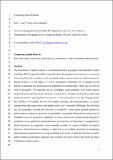Files in this item
Comparing spatial patterns
Item metadata
| dc.contributor.author | Long, Jed | |
| dc.contributor.author | Robertson, Colin | |
| dc.date.accessioned | 2019-12-08T00:36:46Z | |
| dc.date.available | 2019-12-08T00:36:46Z | |
| dc.date.issued | 2018-02 | |
| dc.identifier | 251478204 | |
| dc.identifier | 07fa5f6b-d191-4555-9417-77e6d401422c | |
| dc.identifier | 85041603430 | |
| dc.identifier | 000425181300002 | |
| dc.identifier.citation | Long , J & Robertson , C 2018 , ' Comparing spatial patterns ' , Geography Compass , vol. 12 , no. 2 , e12356 . https://doi.org/10.1111/gec3.12356 | en |
| dc.identifier.issn | 1749-8198 | |
| dc.identifier.uri | https://hdl.handle.net/10023/19092 | |
| dc.description | The second author would like to acknowledge Natural Sciences and Engineering Research Council of Canada for funding this paper. | en |
| dc.description.abstract | The comparison of spatial patterns is a fundamental task in geography and quantitative spatial modelling. With the growth of data being collected with a geospatial element, we are witnessing an increased interest in analyses requiring spatial pattern comparisons (e.g., model assessment and change analysis). In this paper, we review quantitative techniques for comparing spatial patterns, examining key methodological approaches developed both within and beyond the field of geography. We highlight the key challenges using examples from widely known datasets from the spatial analysis literature. Through these examples, we identify a problematic dichotomy between spatial pattern and process—a widespread issue in the age of big geospatial data. Further, we identify the role of complex topology, the interdependence of spatial configuration and composition, and spatial scale as key (research) challenges. Several areas ripe for geographic research are discussed to establish a consolidated research agenda for spatial pattern comparison grounded in quantitative geography. Hierarchical scaling and the modifiable areal unit problem are highlighted as ideas which can be exploited to identify pattern similarities across spatial and temporal scales. Increased use of “time-aware” comparisons of spatial processes are suggested, which properly account for spatial evolution and pattern formation. Simulation-based inference is identified as particularly promising for integrating spatial pattern comparison into existing modelling frameworks. To date, the literature on spatial pattern comparison has been fragmented, and we hope this work will provide a basis for others to build on in future studies. | |
| dc.format.extent | 1183526 | |
| dc.language.iso | eng | |
| dc.relation.ispartof | Geography Compass | en |
| dc.subject | Maps | en |
| dc.subject | Correlation | en |
| dc.subject | Scale | en |
| dc.subject | Bivariate | en |
| dc.subject | Comparison | en |
| dc.subject | Model assessment | en |
| dc.subject | Spatial process | en |
| dc.subject | G Geography (General) | en |
| dc.subject | 3rd-DAS | en |
| dc.subject.lcc | G1 | en |
| dc.title | Comparing spatial patterns | en |
| dc.type | Journal article | en |
| dc.contributor.institution | University of St Andrews. School of Geography & Sustainable Development | en |
| dc.contributor.institution | University of St Andrews. Bell-Edwards Geographic Data Institute | en |
| dc.identifier.doi | https://doi.org/10.1111/gec3.12356 | |
| dc.description.status | Peer reviewed | en |
| dc.date.embargoedUntil | 2019-12-08 |
This item appears in the following Collection(s)
Items in the St Andrews Research Repository are protected by copyright, with all rights reserved, unless otherwise indicated.

